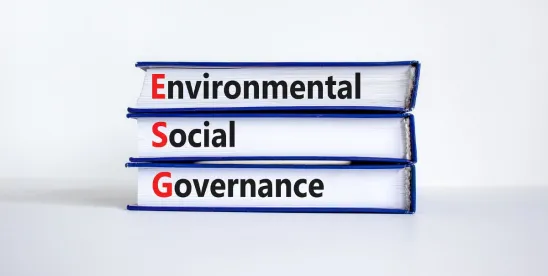Judicial Limits on State and Federal Regulation
The last US Supreme Court term ended with two blockbuster cases in the administrative law space: Loper Bright Enterprises v. Raimondo (discussed here) and Corner Post v. Board of Governors of the Federal Reserve System (discussed here). These decisions illustrated the current Court’s strong views on the policymaking process. In Loper Bright, the Court overturned “Chevron deference,” under which courts deferred to agency interpretations of their own statutory mandates. In its place, the Court established a framework for court “respect” to agency rulemaking, as long as the agency decision presents a convincing rationale for the “best” interpretation of the involved statute. In Corner Post, the Court expressed its openness to business challenges to “old” regulations if a new party was injured.
Loper Bright and Corner Post may touch on lower court decisions that address hot-button issues like environmental, social, and governance (ESG), with the Fifth Circuit remanding Utah v. Su — involving the Biden Administration’s efforts to allow ESG factors in investment decisions — to a lower court for evaluation of Loper Bright’s impact. (For background on Utah v. Su, see here.) Loper Bright is also beginning to impact the energy space. In a case styled Edison Electric Institute v. Federal Energy Regulatory Commission (FERC), the Supreme Court has directed the DC Circuit to review its 2023 decision in Solar Energy Industry Association v. FERC, which approved connection of a Montana solar energy facility to the electric grid. In the case, how the Public Utility Regulatory Policies Act defined “small production facility” was case determinative and the court found that the FERC’s definition was overbroad and out-of-step with the statutory scheme. Without “Chevron deference,” the court chose to follow its best interpretation of the statute instead of merely deferring to FERC’s construction.
Separately, courts will continue to sort out constitutional limits on state efforts with the potential to impact the environmental space. One example of this trend is the August 14 decision by a Missouri federal court in Securities Industry and Financial Markets Association v. Ashcroft,which enjoined on preemption grounds a Missouri state regulator’s “Anti-ESG” rules requiring investment advisors to obtain written consent from customers to “incorporate[] a social objective or other nonfinancial objective” in investment decisions. The decision rejects the Missouri regulations on the grounds they are preempted by preexisting federal laws, which presumably will remain on the books no matter who wins the election.
Increased Focus on Public Input
Many people feel cut off from regulatory processes. The Biden Administration has made efforts ranging from “environmental justice”-related grants programs to changes in the format in which regulatory comments can be received, all aimed at closing these gaps.
Last week, the Environmental Protection Agency (EPA) built upon this effort by issuing its final Achieving Health and Environmental Protection through EPA’s Meaningful Engagement Policy. This policy, which aims to “[r]eaffirm EPA’s commitment to early and frequent outreach, accessibility, and meaningful engagement;” to “[e]nsure that EPA makes its decisions with an understanding of the interests and concerns” of the public; and to “[i]mprive the efficiency, equity, and transparency of EPA’s decisions,” formalizes processes to bolster public participation, provides a public participation model, and offers self-assessment tools that regulators can use to evaluate their public participation efforts.
While the policy states that it does not add “new legal requirements or mandatory obligations,” rolling back commitments to outreach will likely not be politically feasible in an era where commenting on issues that have a local impact — from releases of hazardous waste to construction of renewable energy facilities — has become increasingly nonpartisan in communities across the United States.
“ESG” Wanes While “Sustainability” Rises
While “ESG” has become a political football, non-ESG-related “sustainability” efforts ranging from building codes intending to limit the carbon impact of buildings to state and local efforts to limit single-use plastic products continue to proliferate. State and local governments also continue attempts to address climate issues through tort litigation. Given increased attention to issues like climate issues and health risks potentially posed by microplastics, local political efforts to address them are unlikely to abate.
Legal “Balkanization” Related to Product Regulation
Building on the above theme, our last “year in review” article related to the environment pondered whether “tsunami” decisions like Loper Bright and Corner Post,whichlimit the ability of the federal government’s executive branch to deal with new problems, could “wash away a sea change” (i.e.,the increased salience of environmental issues to politicians at all levels of government).
It appears they have not. In last year’s decision in National Pork Producers Council v. Ross, the Supreme Court permitted state regulations that potentially affect broader national markets to remain on the books, despite a challenge from businesses operating in other states. Ross involved trade groups’ challenge to California’s Proposition 12, which prevents the in-state sale of pork from pigs that are confined in cruel conditions. The trade groups argued that Proposition 12 violated the dormant Commerce Clause by having impermissible extraterritorial effects and causing an excessive burden on interstate commerce. Because most of California’s pork is imported from other states, most pork producers doing business there — in order to remain competitive — don’t follow the requirements. Implementing changes to confinement and monitoring practices would be extremely costly.
Because the public cares about health-related issues, states are likely to continue regulating products containing substances like per- and polyfluoralkyl substances, which are perceived to be associated with health risks. (For an example, see here.) Without federal judicial or legislative action, manufacturers and retailers are likely to face increasing challenges relating to product and distribution due to a hodgepodge of potentially applicable regulations and various sales methods, regardless of who wins the next election.
Equity on the Upswing
Finally, concepts of “generational equity,” i.e.,that older generations have an obligation to protect the environment on behalf of younger generations, have increasing public salience. The past year has seen young plaintiffs in states including Hawaii and Montana secure wins in the form of settlements or establishment of precedent protecting government environmental commitments. Legal victories, combined with increased public attention to harms posed by climate change, are likely to create a self-reinforcing dynamic that spawns efforts ranging from lobbying through litigation to address climate issues. (For more on kinds of pressure campaigns, see here.)




 />i
/>i

